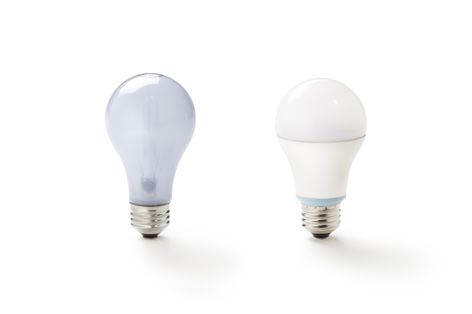• New LED reveal® bulb uses GE technology to avoid dull yellow rays while saving energy
• GE Lighting’s Chief Innovation Manager answers five questions about consumer LED lighting
New reveal® LED light bulbs available this fall from GE Lighting promise to save energy while putting colors and patterns in a whole new light. GE’s new 60-watt standard incandescent replacement reveal LED light bulb is engineered to have the familiar size and shape of an incandescent bulb and deliver big energy savings. In true reveal fashion, it does not produce dull yellow rays like regular bulbs and provides a crisp white light that brings out more vibrant colors and patterns.
“At the forefront of all of our engineering is consumer research, and we heard across the board that the size and the shape of an LED bulb is very important to shoppers,” says Tom Boyle, chief innovation manager, GE Lighting. “As LED technology continues to evolve, producing the same quality of light with smaller bulbs will allow consumers to be more creative with lighting. LEDs can change the way we light our homes.”
The reveal LED light bulb, which will last more than two decades based on three hours of use each day, will be offered in 40- and 60-watt replacements, as well as a popular BR-30 shape for recessed fixture down-lighting. These products are additions to GE’s growing LED portfolio, including 40- and 60-watt incandescent replacement LED bulbs available now and a 100-watt incandescent replacement LED bulb that becomes available later this year.

The energy saving 60-watt incandescent replacement LED bulb is engineered to have the familiar size and shape of an incandescent bulb while providing a crisp white light that brings out more vibrant colors and patterns.
Consumer LED bulb Q-and-A with GE Lighting’s Chief Innovation Manager
Tom Boyle spends his days working with GE scientists, engineers and product developers, shaping the future of consumer lighting. Here, he answers five big questions about how residential lighting will change, thanks to LEDs, in the coming years:
1. What’s next for LED technology?
“Short term, prices will continue to drop as efficiencies are realized in drivers and chips. This will drive wider adoption. We’ll also see more LEDs beginning to fit the traditional A-19 shape. In time, you will have the ability to tune LED light colors, so a consumer could adjust bulbs to emit a ‘cooler’ white light in the office or a ‘warmer’ white light in the bedroom.”
2. What’s the biggest challenge in designing LED bulbs today?
“Design is one challenging area with LED bulbs right now. We face design limitations because we need to manage the thermal loads, or heat, of LED bulbs differently than other technologies. This should become less of an issue as LED chips and drivers evolve. At GE, our daily challenge is to deliver energy-efficient and reliable lighting options without compromising the quality of light.”
3. What needs to happen for consumers to widely embrace LED bulbs?
“In the near term, the price for LEDs—much like other lighting technologies—will need to continue to drop. Also, consumers will need to change how they think about light bulbs. I liken the LED bulb to any other consumer electronic. If we shop for an LED TV, we want the more reliable brand. We’ll pay a little more to have something that looks better and we want to be able to manipulate it and control it with our smartphones. Those are all things that we should, now or in the future, be thinking about relative to LED bulbs.”
4. What pockets of the world will embrace consumer LED bulbs first?
“We’re already seeing LED adoption in places like Japan and Europe where new energy standards and high electricity costs make the longevity and energy savings of LEDs appealing. Also, since LEDs use minimal energy, we see LEDs as a good fit for countries without a lot of infrastructure and in places where people are using generators as a main power source. Early adopters are experimenting with LEDs, especially in hard-to-reach applications where they want to install it and forget it.”
5. Why should consumers trust that a GE LED bulb will perform as promised on the packaging?
“GE’s Nick Holonyak in 1962 became the first person to operate a visible semiconductor alloy laser—the device that illuminated the first visible LED. We collaborate with multiple LED chip suppliers that help us achieve the quality of light our customers expect at a price they can afford. This doesn’t lock us into one solution, which helps foster competitiveness. When there’s competition, our customers win.”












